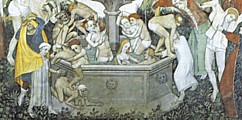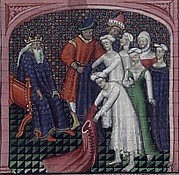
Medieval
Women's Underwear
Exciting new archaeological
finds in 2010 have uncovered what appears to be the first examples
of existing medieval underwear other than the smock or chemise.
These finds come from Castle Ling mountain near Nikolsdorf in
East Tyrol. On the first floor in the south wing of the castle,
filling was removed which, among other things, consisted of textiles
dating from the 14th to 16th centuries. Among these textiles were
items of underwear dating to the late 15th century.
 References
and images of women's underclothing are scanty at best, with it
generally being thought that women wore nothing at all under their
dresses other than the chemise or smock which was made of plain,
white linen. References
and images of women's underclothing are scanty at best, with it
generally being thought that women wore nothing at all under their
dresses other than the chemise or smock which was made of plain,
white linen.
There are, however, a few
small references here and there which leads to the belief that
items of underclothing were indeed worn. The detail shown above
is from the fresco painted in 1411-1416 by Di Manta, The Fountain
Of Youth, which shows people of both sexes in various stages
of undress.
The following pages look
at the various aspects of female underclothing.
CHEMISES
The chemise, shift or smock
BRAS & BUST SUPPORT
Bras, support and structure
UNDERPANTS
What did they wear 'down there'
HOSE & GARTERS
Leg coverings, socks and support

One reference to underclothing
comes from Ellen of Udine. As a widow, she took a vow of silence
and adopted harsh penitents to atone for her former sinful and
worldly life. She confessed:
I wear a hair shirt
because of the silken undergarments... with which I used to
clothe myself.
Although this reference is
quite vague as to what kinds of underclothing she is actually
referring to giving up, the use of the plural makes me personally
feel that possibly it may be more than one kind of garment and
not just the single item- the chemise. She could, of course, be
using the plural form to indicate that she owned many of the same
item and not more than one item worn together.
In a paragraph about taking care of aged widows, it is written
that a corrody or old age allowance was to be provided. This particular
examples cites:
..a daily ration of
bread and ale, a dish with pottage from the monastery kitchen,
firewood, a room, a servant, a new robe, shoes and underlinen
once a year, candles and fodder for stalling a horse..
 Again
it is not specified as to exactly what undergarment or garments
this passage refers to, whether it is just a single smock or an
ensemble. Again
it is not specified as to exactly what undergarment or garments
this passage refers to, whether it is just a single smock or an
ensemble.
It is also recorded that
in 1397 Margherita Datini owned a shift of fine linen over which
in winter she wore a petticoat of wool or fur- otter, cat or miniver.
Her gown and surcote were worn over those other two layers and
a cloak over that.
The illumination at right from the early 1400s, Dionysus I
humiliates the women of Locri shows women removing their outer
garments to reveal a plain white opaque smock or shift with a
very low,wide neck which accommodates the low, wide fashions of
the day without showing.

Copyright
© Rosalie Gilbert
All text & photographs within this site are the property of
Rosalie Gilbert unless stated.
Art & artifact images remain the property of the owner.
Images and text may not be copied and used without permission.
|